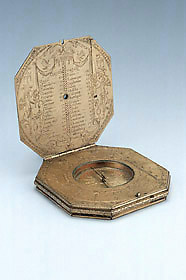
 |
| Catalogue |
 |
 Astronomical Compendium The front face carries a nocturnal and a universal equinoctial dial. The nocturnal is constructed for a star with right ascension of about 20? Libra and has both a calendar and a zodiac scale. The zodiac is the outer of these two circular fixed scales. Each sign of the zodiac and each calendar month is divided by 10, 5 and 1, and numbered by 10 (adjusted for the lengths of the months). The division for June is decorated with a flower and that for August with a wheatsheaf. The first point of Aries is fixed at 11 March. The nocturnal has a silver hour ring 1 to 12, 1 to 12, divided and numbered by 1. Each hour has a pointer to enable the hours to be read by touch, and there is a longer pointer at 12 for setting the instrument. The index arm is marked 'INDEX' and its projecting end folds in towards the centre of the instrument. The index also provides the support for the folding semicircular gnomon of the equinoctial dial. There are two fixed scales of hours within the nocturnal's revolving hour ring: a brass ring of 'Horae Comunes' II to XII, I to X and a silver ring of 'Horae Italice' 6 to 24. The reverse of the cover provides a table of latitudes, titled 'ELEVATIO POLI ARC' and covering 32 European cities from Edinburgh to Granada. The maker's signature appears under the table: 'Philipus Danfrie fecit'. Recessed on this face is the hinged support for elevating the dial plate. Its end is set on the latitude scale of the opposite face, which runs 0 to 75, divided to 10 and 1, and numbered by 10. In use, the compendium is orientated using its compass and the dial plate is set for the appropriate latitude. The index is then rotated until the raised semi-circular gnomon is aligned with the direction of the sun. The time can then be read off from the edge of the index. However, the scale of ordinary equal hours is not correctly oriented, and reads approximately 8 o'clock when it should be midday. Some damage at the 'm' of 'Comunes' suggests that a previous owner may have attempted to push the ring round. The scale of Italian hours also poses a problem. It should be adjustable relative to the scale of ordinary hours since the time of sunset varies throughout the year. Yet it appears to be fixed, though there is a small hole which has evidently been used. Even if the scale could be rotated it would need to be set against a special calendar scale. The compass is on the same face as the latitude scale. The recessed bowl (diameter 49 mm) has decorated lines for 8 principal directions and the four cardinal points of the compass are marked as 'SEPTEN', 'ORIENS', 'MERIDIES' and 'OCCIDE<N>S'. The division of the compass circle is completed by a scale at the circumference of the bowl in 64 parts, divided to 4, 2 and 1. Surrounding the compass bowl is a circular scale of degrees 90 to 0 to 90 to 0 to 90, divided to 10 and 2, and numbered by 10. Strapwork pointers indicate the directions of the eight winds marked in French and Italian. The back cover plate is slightly recessed to ensure that its alidade does not project. The alidade carries two folding pin sights. Observations are read against a circular scale of degrees 90 to 0 to 90 to 0 to 90, divided to 10, 5 and 1, and numbered by 10. Inside the lower semicircle is a shadow square marked 'VMBRA RECTA' and 'VMBRA VERSA', each portion 0 to 12, divided to 3 and 1, and numbered by 3. Inside the upper semicircle is a roundel with a coat of arms. The right quadrant is engraved with a diagram of unequal hours ('Horae inaequales'). The absence of graduation on the alidade would have made this difficult to use, and the necessary information on the sun's maximum altitude would have had to be independently provided. Stephen Johnston |



